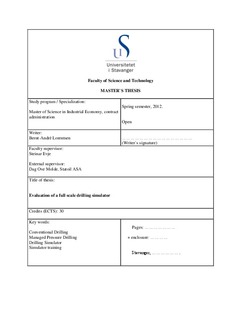| dc.description.abstract | Nowadays, one can often hear the saying: “the easy oil is gone, the future will bring more complex and challenging wells to be drilled”. In fact, this is something the industry already is facing. Oilfields are depleting and ageing, which forces the operators to search for oil and gas in harsher and more challenging areas. This thesis presents a detailed description of a full scale drilling simulator developed by Statoil and cooperating partners; SINTEF, eDrilling and Oiltec Solutions. The simulator was developed as a consequence of several serious incidents during the period 2007 – 2008. Statoil`s intention is to ensure optimal competence level for its Drilling & Well personnel by offering realistic personnel training on operational procedures and well control incidents in a non-threatening environment. This gives each license a unique opportunity to train of field specific challenges.
The simulator contains a great flexibility due to its modularity which enables training on a variety of different drilling operations. As of today, is conventional drilling fully implemented with capability of performing training in HPHT mode. Generally will MPD operations require more equipment and a higher competence requirement compared to conventional drilling, and will thus require more time for training. The newly developed MPD module will be implemented during the month of July. Since this is the next extension of drilling simulator application, have this thesis assessed the potential of performing training of drilling & well personnel in MPD mode. Related drilling problems have also been presented due to its relevance for simulator training in both conventional drilling and MPD mode. Successful training and improvement of personnel`s action in different scenarios requires realistic cases with a rig setup close to what the personnel is used to. Hence, the simulator is configured to replicate the actual drilling rig and well data for applicable wells. A comparison between Statoil`s in-house planning tool, Drillbench, and SINTEF`s, Intellectus, have been presented in a comparison of simulated results. The result shows that both planning tools are to be consistent and aligned and shows that simulated data from simulator training is in accordance with the planning each licensee have performed in advance. An comparison of real-time ECD and simulated ECD values shows that Drillbench conducts simulations that are both reliable and realistic when the drilling parameters are the same.
Through the period from January 2012 – June 2012, there have been 40 classes of training comprised on 287 participants. Each participant have filled out an evaluation scheme which has formed the basis of my evaluation of simulator training. The performed simulator training shows to increase the general downhole understanding of participants and it is an important risk reducing action for Statoil. Feedback from participants shows that mud engineers, drilling engineers and cementers easily become passive observer’s during training. It is proposed to define specific tasks for each participant which will contribute to more engagement throughout the team. With 95,2 % of all participants expressing a desire to come back for further simulator training, is this initiative proving to be attractive among the participants. | no_NO |
